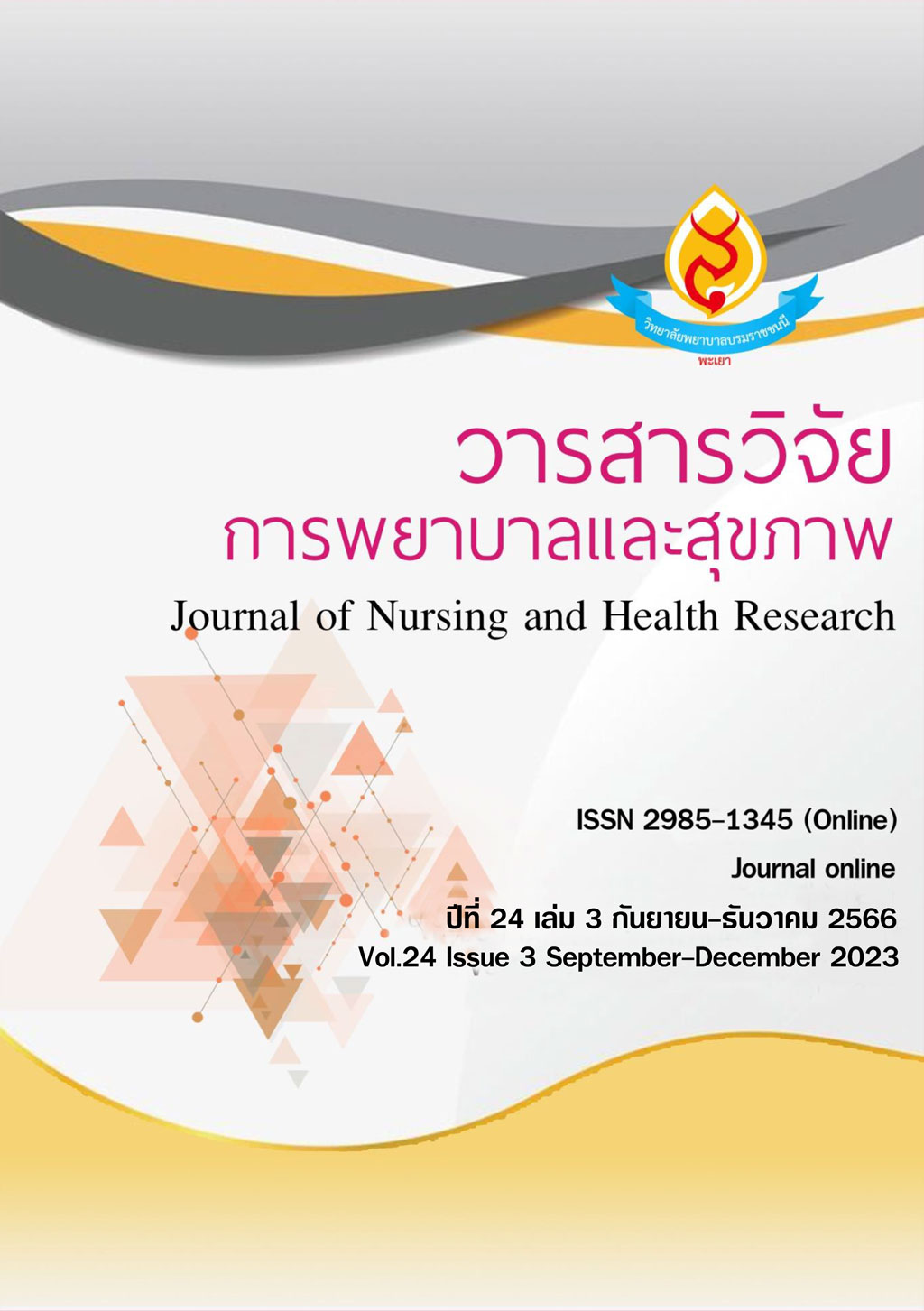ปัจจัยที่มีความสัมพันธ์กับพฤติกรรมการบริโภคเกลือโซเดียมในนักศึกษาพยาบาล
คำสำคัญ:
พฤติกรรมการบริโภค, เกลือโซเดียม, นักศึกษาพยาบาลบทคัดย่อ
การบริโภคเกลือโซเดียมในปริมาณสูงมีความสัมพันธ์ต่อการเกิดโรคความดันโลหิตสูง โรคไต และโรคหลอดเลือดสมอง ซึ่งเป็นปัญหาสำคัญทางสาธารณสุขของประเทศ และทั้งโลก นักศึกษาพยาบาลเป็นบุคลากรสุขภาพที่ต้องเป็นแบบอย่างด้านสุขภาพจึงควรมีพฤติกรรมการบริโภคเกลือโซเดียมในปริมาณที่เหมาะสม การวิจัยพรรณนาเชิงความสัมพันธ์ครั้งนี้มีวัตถุประสงค์เพื่อศึกษาพฤติกรรมการบริโภคเกลือโซเดียมและปัจจัยที่มีความสัมพันธ์กับพฤติกรรมการบริโภคเกลือโซเดียมในนักศึกษาพยาบาล เลือกกลุ่มตัวอย่างแบบเจาะจง โดยศึกษาในนักศึกษาพยาบาลชั้นปีที่ 1 ถึงชั้นปีที่ 4 ในปีการศึกษา 2565 จำนวน 217 คน เครื่องมือวิจัย เป็นแบบสอบถาม 5 ส่วน คือ ข้อมูลทั่วไป ปัจจัยนำ ปัจจัยเอื้อ ปัจจัยเสริม และพฤติกรรมการบริโภคเกลือโซเดียม ได้รับการตรวจสอบคุณภาพจากผู้เชี่ยวชาญ 3 คน เก็บรวมรวมข้อมูลโดยใช้แบบทดสอบออนไลน์ วิเคราะห์ข้อมูลด้วยสถิติพรรณนา วิเคราะห์ความสัมพันธ์โดยใช้สถิติไควแควร์ และค่าสหสัมพันธ์แบบเพียร์สัน ผลการศึกษา พบว่า ด้านปัจจัยนำ พบ นักศึกษามีความรู้ และพฤติกรรมการบริโภคเกลือโซเดียมภาพรวมอยู่ในระดับปานกลาง แต่มีทัศนคติในการบริโภคเกลือโซเดียมอยู่ในระดับดี ปัจจัยเอื้อ พบ นักศึกษาสามารถเข้าถึงบริการหรือแหล่งอาหารภาพรวมอยู่ในระดับปานกลาง ปัจจัยเสริม พบ นักศึกษามีการได้รับข่าวสาร/ข้อมูลเกี่ยวกับการบริโภคเกลือโซเดียมภาพรวมอยู่ในระดับปานกลาง และได้รับกระตุ้นเตือนจากบุคคลในการบริโภคเกลือโซเดียมภาพรวมอยู่ในระดับต่ำ และนักศึกษามีพฤติกรรมการบริโภคเกลือโซเดียมภาพรวมอยู่ในระดับปานกลาง สำหรับปัจจัยที่มีความสัมพันธ์กับพฤติกรรมการบริโภคเกลือโซเดียมอย่างมีนัยสำคัญทางสถิติ ได้แก่ อายุ มีความสัมพันธ์ทางบวกในระดับต่ำ (r=.149, p<.05) และความสามารถในการเข้าถึงบริการหรือแหล่งอาหารมีความสัมพันธ์ทางบวกในระดับต่ำ (r=.156, p<.05) ข้อเสนอแนะในการวิจัยคือ ควรมีกิจกรรมการส่งเสริมความรู้เรื่องผลกระทบต่อสุขภาพ ให้กับนักศึกษาอย่างต่อเนื่อง เพื่อให้เกิดการปรับเปลี่ยนพฤติกรรมการบริโภคเกลือโซเดียมต่ำ และเพิ่มการเข้าถึงแหล่งอาหารและบริการที่หลากหลาย เพื่อให้นักศึกษามีตัวเลือกในการบริโภคอาหารที่มีเกลือโซเดียมในปริมาณน้อย
เอกสารอ้างอิง
กรมควบคุมโรค สำนักโรคไม่ติดต่อ. (2559). ยุทธศาสตร์ลดการบริโภคเกลือและโซเดียมในประเทศไทย พ.ศ. 2559-2568. กรุงเทพมหานคร: สำนักงานกิจการโรงพิมพ์องค์การสงเคราะห์ทหารผ่านศึก ในพระบรมราชูปถัมภ์.
กองยุทธศาสตร์และแผนงาน สำนักงานปลัดกระทรวง สาธารณสุข. (2562). สถิติสาธารณสุข 2562. นนทบุรี: สำนักงานปลัดกระทรวงสาธารณสุข.
ชลธิชา บุญศิริ, นพวรรณ เปียซื่อ, พรรณวดี พุธวัฒนะ และ สุรศักดิ์ กันตชูเวสศิริ. (2560). ผลของโปรแกรมส่งเสริมการบริโภคอาหารลดโซเดียมต่อความรู้และปริมาณโซเดียมในปัสสาวะของนักศึกษาพยาบาล. วารสารพยาบาล, 32(3), 104-119.
ประทุม เมืองเป้ และ วุฒิชัย จริยา (2023). ปัจจัยทำนายพฤติกรรมลดการบริโภคเกลือและโซเดียมของกลุ่มเสี่ยงโรคความดันโลหิตสูง อำเภอหนองไผ่ จังหวัดเพชรบูรณ์. วารสารวิชาการสาธารณสุข, 32(1), 19-30.
ปรัศนี ศรีกัน, สมศรี ทาทาน, วราภรณ์ ศรีจันทร์พาล และ ชลธิมา ปิ่นสกุล. (2561). ความสัมพันธ์ระหว่างความรู้ ความสามารถในการดูแลตนเอง พฤติกรรมการลดการบริโภคอาหารที่มีโซเดียมสูง และปริมาณโซเดียมในปัสสาวะของนักศึกษาและบุคลากรของวิทยาลัยพยาบาลบรมราชชนนี พะเยา. วารสารวิทยาลัยพยาบาลบรมราชชนนี กรุงเทพ, 34(3), 21-33.
พชรวดี กาญจรัส. (2557). การบริโภคโซเดียมในกลุ่มเสี่ยงสูงต่อ โรคความดันโลหิตสูง อำเภอโพธิ์ ศรีสุวรรณจังหวัดศรีสะเกษ. (วิทยานิพนธ์ปริญญามหาบัณฑิต). ขอนแก่น: มหาวิทยาลัยขอนแก่น.
พัชนี ถิระกุลพฤทธิ์. (2559). ปัจจัยที่มีผลต่อพฤติกรรมการบริโภค เกลือโซเดียมของครัวเรือน ในตำบลบางหมาก อำเภอกันตัง จังหวัดตรัง. ตรัง: วิทยาลัยการสาธารณสุขสิรินธร จังหวัดตรัง.
วิชัย เอกพลากร. (2557). รายงานการสำรวจสุขภาพประชาชนไทยโดยการตรวจร่างกาย ครั้งที่ 5 พ.ศ. 2557. นนทบุรี: สถาบันวิจัยระบบสาธารณสุข.
วิชัย เอกพลากร. (2564). รายงานการสำรวจสุขภาพประชาชนไทยโดยการตรวจร่างกาย ครั้งที 6 พ.ศ. 2562-2563. กรุงเทพมหานคร: อักษรกราฟฟิกแอนด์ดีไซน์.
วิทยาลัยพยาบาลบรมราชชนนี พะเยา. (2565). คู่มือจัดการศึกษาประจำปีการศึกษา 2565 วิทยาลัยพยาบาลบรมราชชนนี พะเยา คณะพยาบาลศาสตร์ สถาบันพระบรมราชชนก. พะเยา: วิทยาลัยพยาบาลบรมราชชนนี พะเยา
สิริมนต์ ชายเกตุ. (2559) ปัจจัยที่มีความสัมพันธ์กับโซเดียมจากอาหารที่บริโภคของนิสิต มหาวิทยาลัยศรีนครินทรวิโรฒ ประสานมิตร. วารสารหน่วยวิจัยวิทยาศาสตร์ เทคโนโลยี และสิ่งแวดล้อมเพื่อการเรียนรู้, 7(1),103-114.
สำนักงานคณะกรรมการสุขภาพแห่งชาติ. (2559). เอกสารหลักประกอบการพิจารณามติสมัชชาสุขภาพแห่งชาติครั้งที่ 8 พ.ศ. 2558: นโยบายการลดบริโภคเกลือและโซเดียมเพื่อลดโรคไม่ติดต่อ (NCDs). นนทบุรี: สำนักงานคณะกรรมการสุขภาพแห่งชาติ.
Batcagan-Abueg, A. P. M., Lee, J. J., Chan, P., Rebello, S. A., & Amarra, M. S. (2013). Salt intakes and salt reduction initiatives in Southeast Asia: A review. Asia Pacific Journal of Clinical Nutrition, 22(4), 490–504.
Best, J. (1977). Research in Education. New Jersey: Prentice Hall.
Biswas, J., Haque, M.M., Mahbub, S., Md., Nurani, N.R., Shah, N.A., Barua, L., … Zaman, M.M. (2020). Salt intake behavior among the undergraduate students of Bangladesh University of Health Sciences. Journal of Xiangya Medicine, 5(24), 1-8. doi: 10.21037/jxym-2
Bloom, B. S., Madaus, G. F., & Hastings, J. T. (1971). Handbook on Formative and Summative Evaluation of Student Learning. New York: McGraw-Hill.
Chailimpamontree, W., Kantachuvesiri, S., Aekplakorn, W., Lappichetpaiboon, R., Thokanit, S.N., Vathesatogkit, P., ... Garg, R. (2021). Estimated dietary sodium intake in Thailand: A nationwide population survey with 24-hour urine collections. The Journal of Clinical Hypertension, 23, 744–754. doi: 10.1111/jch.14147
Colin-Ramires, E., Espinosa-Cuevas, A., Miranda-Alatriste., P.V., Tovar-Villegas, V.I., Arcand, J., & Correa-Rotter, R. (2017). Food sources of sodium intake in an adult Mexican population: A sub-analysis of the SALMEX study. Nutrients, 9(8), 810. doi: 10.3390/nu9080810
Green, L., & Krueter, M. (1999). Health Promotion Planning: An Education approach (3rd ed.). Toronto: Mayfield Publishing.
Ismail, L., Hashim, M., Jarrar, A. H., Mohamad, M. N., Daour, R. A., Rajaby, R. A., ... Dhaheri, A. S. A. (2022). Impact of a nutrition education intervention on Salt/Sodium related knowledge, attitude, and practice of university students. Frontiers in Nutrition, 9, 1-11. doi: 10.3389/fnut.2022.830262
Krejcie, R. V., & Morgan, D. W. (1970). Determining sample size for research activities. Educational and Psychological Measurement, 30(3), 607–610.
Roth, G. A., Johnson, C. O., Abajobir, A. A., Abd-Allah, F., Abera, S. F., Abyu, G. Y., ... Murray, C. J. L. (2017). Global, regional, and national burden of cardiovascular diseases for 10 causes, 1990 to 2015. Journal of the American College of Cardiology, 70(1), 1–25. doi: 10.1016/j.jacc.2017.04.052
Shah, K., Shah, H., Vijan, S., Kamat, S., Kirpalani, D., & Kirpalani, A. (2022). The salt study-salt intake in adolescents today. Journal of Hypertension, 40(Suppl 1), e153. doi: 10.1097/01.hjh.0000836892.98694.9d
U.S. Department of Health and Human Services. (2016). New research: Excess sodium intake remains common in the United States. Centers for Disease Control and Prevention, 1, 1–2.
ดาวน์โหลด
เผยแพร่แล้ว
รูปแบบการอ้างอิง
ฉบับ
ประเภทบทความ
สัญญาอนุญาต
ลิขสิทธิ์ (c) 2023 วารสารวิจัยการพยาบาลและสุขภาพ

อนุญาตภายใต้เงื่อนไข Creative Commons Attribution-NonCommercial-NoDerivatives 4.0 International License.



